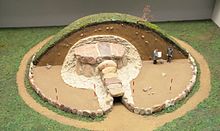
A passage grave or passage tomb consists of one or more burial chambers covered in earth or stone and having a narrow access passage made of large stones. These structures usually date from the Neolithic Age and are found largely in Western Europe. [1] When covered in earth, a passage grave is a type of burial mound [2] which is found in various forms all over the world. When a passage grave is covered in stone, it is a type of cairn.
